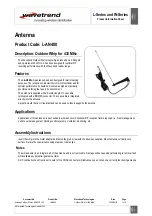
Performance optimization for blockage
C-2
The simple time-out means that there is a fixed delay, plus the time needed to acquire
another satellite, before there is a chance of regaining good link performance.
If the signal is not sent to the modem, the system can in some cases remain linked and
have a higher uptime, but not provide a stable data connection. Such a link is of no value
to the subscriber. Not sending the blockage (TX-Mute) signal also extends the period of
the poor-quality link, as the VSAT modem is still relying on a time-out before switching
to another satellite, and the time-out may be constantly reset by the link coming and
going.
Better blockage communication
A major disadvantage of this single signal is that if the VSAT modem has multiple
satellites to choose from, then, when selecting a new satellite, the VSAT modem is again
relying on the simple time-out. This continues until a satellite with no obstruction in the
view from the satellite terminal is selected. If the VSAT modem was able to receive
information from the ACU that the view towards the current satellite is blocked, it would
be able to choose a visible satellite much faster without the need to wait for multiple time-
outs.
Minimum elevation angle
One safe way of getting optimum performance under the current conditions is to switch to
a satellite in view as fast as possible. This is done by having well defined satellite
parameters in the VSAT modem configuration. It is the VSAT modem that has the task of
selecting the correct satellite, and since the VSAT modem is only concerned about the
satellite visibility at the current geographic position, it is very important to enter the
minimum elevation of a satellite at which a stable link can be established.
It is often seen that the minimum elevation is set to 0 (zero). A setting of 0 is not only in
many cases below the usable limit of the satellite, but also a violation against ETSI EN
302 340, where a calculated minimum elevation ranges from 12° to 3° depending on
power and bandwidth must be ensured or FCC §25.205 which states the minimum
elevation to be 5°. See also Table 5-15 on page 5-26.
Unless the vessel is operating in international waters with no other options, a minimum
elevation of 10° or higher is recommended.
Conclusion
Fewer but well-functioning satellites to choose from give better user performance than
having many satellites, which may have a longer uptime but do not provide a stable data
connection. In the end it is not the actual uptime the subscriber is concerned about, but it
is the uptime where the link gives a stable data connection.
Содержание FV-110
Страница 1: ...KU BAND ANTENNA FV 110 OPERATOR S MANUAL www furuno com Model...
Страница 54: ...To install the dual antenna mode optional 2 30 This page is intentionally left blank...
Страница 60: ...Interfaces of the VMU 3 6 This page is intentionally left blank...
Страница 116: ...SNMP support 5 54 This page is intentionally left blank...
Страница 122: ...Installation check list Functional test in harbor 6 6 This page is intentionally left blank...
Страница 142: ...Modem Cable iNFINITI iDirect VSAT modem B 4 This page is intentionally left blank...
Страница 178: ...Linkway S2 modem C 36 This page is intentionally left blank...
Страница 192: ...E 4 This page is intentionally left blank...
Страница 204: ...RF interference F 12 This page is intentionally left blank...
Страница 218: ...OEM declaration H 2 H 2 OEM declaration...
Страница 219: ...CE R TTE H 3 H 3 CE R TTE The FV 110 is CE certified R TTE directive as stated in the EU Declaration of Conformity...
Страница 220: ...Eutelsat S A ESV Summary Sheet H 4 H 4 Eutelsat S A ESV Summary Sheet...
Страница 221: ...Russian Maritime Register of Shipping H 5 H 5 Russian Maritime Register of Shipping...
Страница 222: ...Russian Maritime Register of Shipping H 6...
Страница 223: ...Russian Maritime Register of Shipping H 7...
Страница 229: ...OD 1 15 Feb 2017 H MAKI...
Страница 230: ...OD 2 16 Feb 2017 H MAKI...
Страница 232: ......
















































